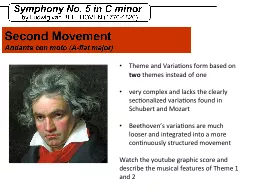

two themes instead of one very complex and lacks the clearly sectionalized variations found in Schubert and Mozart Beethovens variations are much looser and integrated into a more continuously structured movement ID: 601213
Download Presentation The PPT/PDF document "Theme and Variations form based on" is the property of its rightful owner. Permission is granted to download and print the materials on this web site for personal, non-commercial use only, and to display it on your personal computer provided you do not modify the materials and that you retain all copyright notices contained in the materials. By downloading content from our website, you accept the terms of this agreement.
Slide1
Theme and Variations form based on
two
themes instead of one
very complex and lacks the clearly sectionalized variations found in Schubert and Mozart
Beethoven’s variations
are much looser and integrated into a more continuously structured movement
Watch the
youtube
graphic score and describe the musical features of Theme 1 and 2Slide2
Very lyrical
Quiet and reflective
Lots of dotted rhythms
Played be violas and cellos accompanied by pizzicato basses, woodwinds continue the theme
Soft
Theme 1
Theme
1 (0.00)Slide3
Even more rhythmic
Clarinet and Bassoon present the theme accompanied by a triplet theme in the violas
Becomes triumphant and majestic played by the trumpets, horns and full orchestra in the key of C major (1.42)
Theme
2
Theme
2 (1.17) Slide4
What changes and contrast does Beethoven use in his first variation?
Variation 1 (2:35)Slide5
What changes and contrast does Beethoven use in his first variation?
Theme 1 –
Faster notes again-quadruplet rhythmic patternForm is freer and longer
Variation 1Slide6
What changes and contrast does Beethoven use in his second variation?
Variation 2 (4:59)Slide7
What changes and contrast does Beethoven use in his first variation?
Theme 1 –
Faster notes Smoothing out previously dotted notes
Other strings and winds accompany and join in variation process
First violins have a section by themselves and then Cellos and Basses play a very extroverted version of the theme (now not soft for the first time) (5:48)
Theme 2 – Violas now have quadruple pattern
Variation 2 (4:59)Slide8
Played by the woodwinds – up till now it was played by the strings only so they finally get a turn to play by themselves
Supported by the strings
Key change to a minor
Variation 3 (8.19)Slide9
Variation 4 (10:14)
Solo Bassoon
CODA/Variation 5 (11:23)
Mysterious with the woodwinds playing very softly
Built up over repeated tonic chords
Ending
strong and positive in typical Beethoven style
Variations 4 & 5Slide10
Movements III and IV
What would be the typical
structure of the III movement in a symphony by Mozart or Haydn?Why was the trio in a symphony called a trio? What did Beethoven do that was unusual in the III movement?
Describe how the theme from the scherzo links back to the original motif?
What would typically happen in the Trio section
What does the musical term
fugato mean? How does Beethoven use the fugato in his trio section?Give examples of how Beethoven break the rules established by Mozart
and Haydn during the repeat of the A sectionWhat makes the transition between Movements III and IV one of the ‘most remarkable moments in music’?
How does Beethoven move from darkness to light?
How does Beethoven extend the last movement?Slide11Slide12
KEY DIFFERENCES
between Mozart & Haydn v Beethoven
Obvious differences arethe size and nature of the orchestrasexpansion
of dynamic
range
the
much greater lengththe transformation of the third movement into a much faster Scherzo (together with its change of scoring detail, e.g. pizzicato, in its repeat) its extensive link and lack of break before the 4th movement. The opening of the last movement of the Beethoven Symphony, following the long build-up, offers a striking example of the effect which a minor/major contrast can make.
the first movement, in particular, offers early opportunities to hear a new approach, e.g. it does not open with a theme expressed in clearly-balanced 4 + 4-bar phrases – the stop-start pauses signal a more ‘motivic’ technique; two unison horns at bar 59 are given a prominent thematic role.
Beethoven’s modulations range far more widely (for effect in their own right, but also to sustain the greater length of the movements).Slide13
There are strong underlying similarities of structure: the number and nature of movements, the use of Sonata Form,
Menuet (Scherzo) and Trio and repeats. Both second movements use variations (though Beethoven’s are much looser and integrated into a more continuously structured movement). The harmonic language, in terms of tonic/dominant and use of cadences is there, but Beethoven’s modulations range far more widely (for effect in their own right, but also to sustain the greater length of the movements). The famous repeated perfect cadences at the end of Beethoven’s last movement might well be compared
with some of Mozart’s repetitions – not as many, but emphatic and, judged in accordance with overall proportions, similar in their intentions of confirming finality.
KEY DIFFERENCES
between Mozart & Haydn v BeethovenSlide14
Useful Sites
http://www.npr.org/templates/story/story.php?storyId=
5473894http://legacy.earlham.edu/~tobeyfo/musictheory/Book1/FFH1_CH7/7C_Beethoven5.html
https://en.wikipedia.org/wiki/Symphony_No._5_(
Beethoven
)